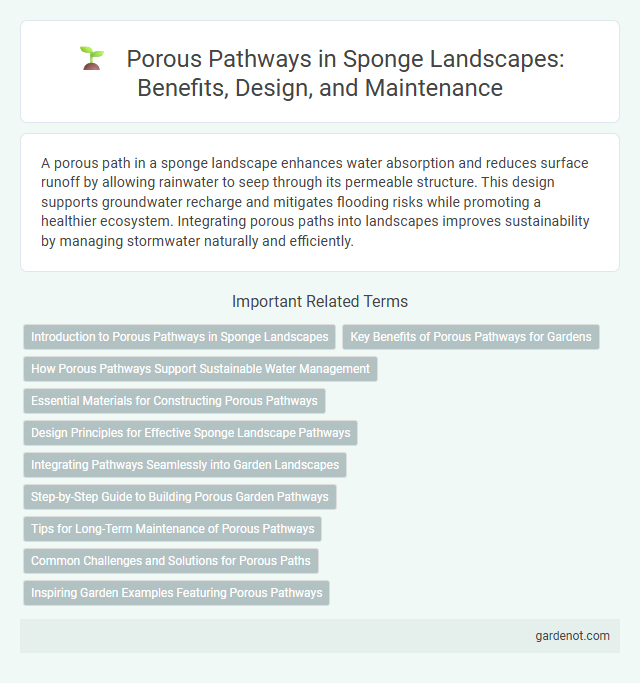A porous path in a sponge landscape enhances water absorption and reduces surface runoff by allowing rainwater to seep through its permeable structure. This design supports groundwater recharge and mitigates flooding risks while promoting a healthier ecosystem. Integrating porous paths into landscapes improves sustainability by managing stormwater naturally and efficiently.
Introduction to Porous Pathways in Sponge Landscapes
Porous pathways in sponge landscapes function as permeable channels that enhance water infiltration and distribution while reducing surface runoff. These pathways utilize materials like permeable pavers, gravel, and sand to support effective stormwater management and groundwater recharge. Integrating porous pathways contributes to sustainable urban drainage systems by mimicking natural hydrological processes.
Key Benefits of Porous Pathways for Gardens
Porous pathways in sponge landscapes enhance garden sustainability by facilitating efficient stormwater infiltration, reducing runoff and soil erosion. These permeable surfaces promote groundwater recharge and minimize flooding risks, supporting healthier plant growth and a balanced ecosystem. Incorporating porous pathways contributes to eco-friendly garden design, improving overall water management and landscape resilience.
How Porous Pathways Support Sustainable Water Management
Porous pathways enhance sustainable water management by allowing rainwater to infiltrate the ground, reducing surface runoff and minimizing flood risks. These permeable surfaces filter pollutants, improving groundwater quality and supporting urban aquifers. Integrating porous paths within sponge landscapes promotes efficient water absorption, aiding in groundwater recharge and mitigating urban heat island effects.
Essential Materials for Constructing Porous Pathways
Essential materials for constructing porous pathways in sponge landscapes include permeable aggregates such as gravel, crushed stone, and porous concrete, which facilitate water infiltration and reduce runoff. Incorporating geotextiles enhances stability while maintaining permeability, preventing soil erosion beneath the surface. Utilizing native sand and organic matter further supports natural water absorption and promotes sustainable drainage in these pathways.
Design Principles for Effective Sponge Landscape Pathways
Porous paths in sponge landscapes utilize permeable materials such as gravel or permeable pavers to enhance water infiltration and reduce surface runoff. Effective design principles emphasize proper grading to direct water towards infiltration zones while maintaining stability and durability for foot traffic. Integrating vegetation alongside pathways further supports natural absorption, minimizes erosion, and promotes groundwater recharge.
Integrating Pathways Seamlessly into Garden Landscapes
Porous paths enhance garden landscapes by promoting natural water infiltration and reducing runoff, supporting sustainable stormwater management. These pathways, constructed with permeable materials like gravel or permeable pavers, blend seamlessly with greenery, maintaining aesthetic harmony while improving soil health. Integrating porous paths into sponge landscapes optimizes groundwater recharge and minimizes erosion, fostering resilient and eco-friendly outdoor spaces.
Step-by-Step Guide to Building Porous Garden Pathways
Creating porous garden pathways involves layering materials like crushed stone and permeable pavers to facilitate water infiltration and reduce runoff. Begin with excavating the path area, install a geotextile fabric to prevent soil mixing, and add a base layer of coarse gravel for drainage. Finish by placing porous surface materials, ensuring each layer is compacted to maintain stability while allowing rainwater absorption, enhancing sustainable sponge landscape design.
Tips for Long-Term Maintenance of Porous Pathways
Regularly clearing debris and leaves from a porous path prevents clogging, ensuring optimal water infiltration and drainage. Periodic pressure washing or vacuuming helps maintain permeability by removing accumulated sediments within the substrate. Incorporating routine inspections to identify and repair compacted or damaged sections preserves the path's structural integrity and functionality over time.
Common Challenges and Solutions for Porous Paths
Porous paths often face common challenges such as sediment clogging, uneven surface settling, and limited load-bearing capacity, which can compromise drainage efficiency and structural integrity. Effective solutions include regular maintenance to remove debris, using high-quality permeable materials with proper sub-base preparation, and integrating structural reinforcement techniques to enhance durability. Implementing these strategies optimizes water infiltration and extends the lifespan of porous paths in sponge landscapes.
Inspiring Garden Examples Featuring Porous Pathways
Inspiring garden examples featuring porous pathways showcase sustainable landscaping by promoting effective stormwater management through permeable materials like gravel, permeable pavers, and decomposed granite. These porous paths reduce runoff, prevent soil erosion, and recharge groundwater while enhancing garden aesthetics with natural textures and organic flow. Integrating such pathways in sponge landscapes demonstrates eco-friendly design principles that balance beauty with environmental functionality.
Porous path Infographic

 gardenot.com
gardenot.com